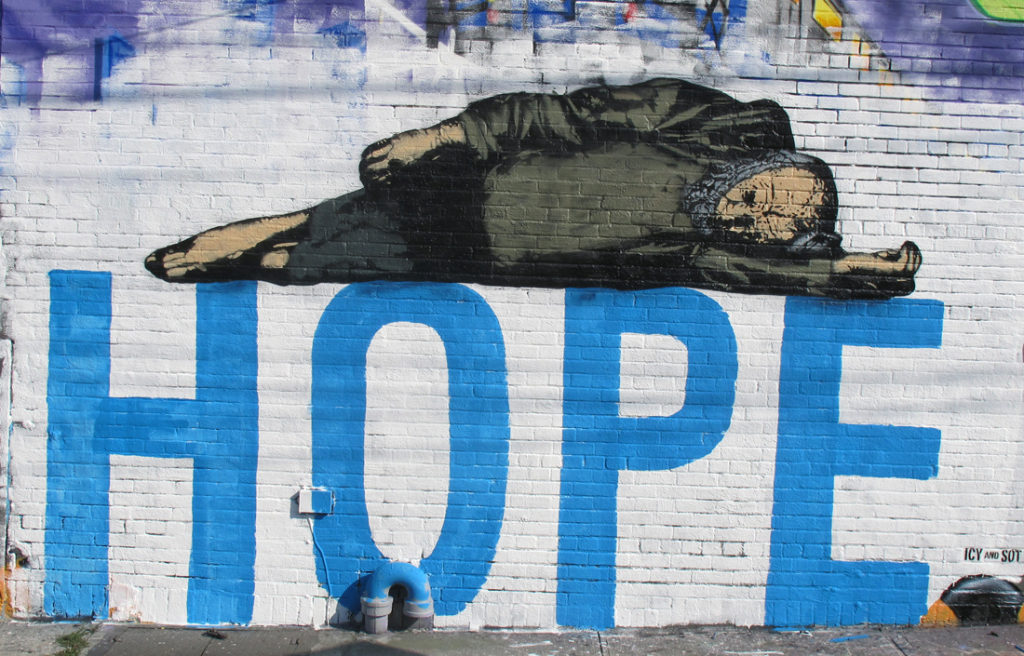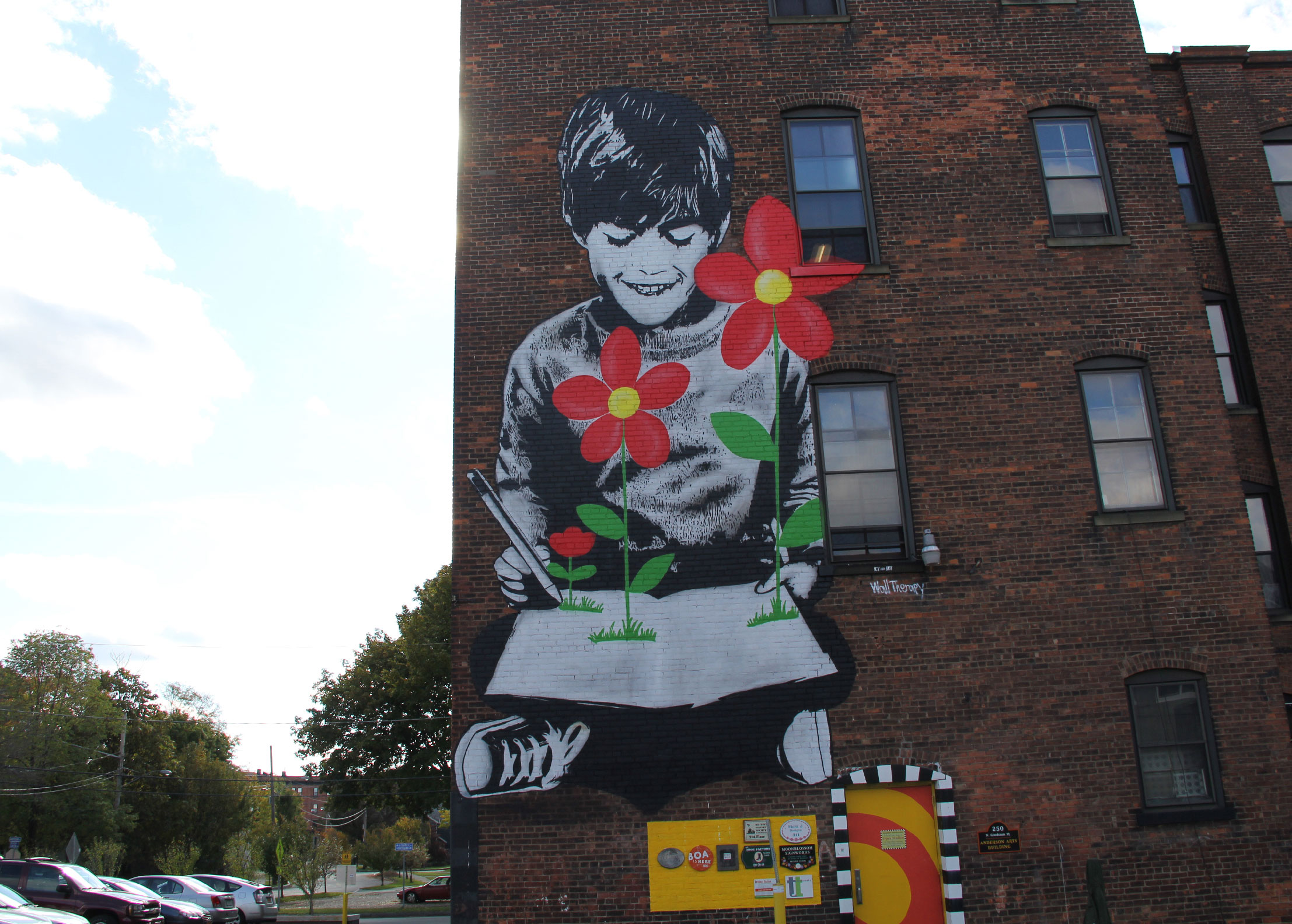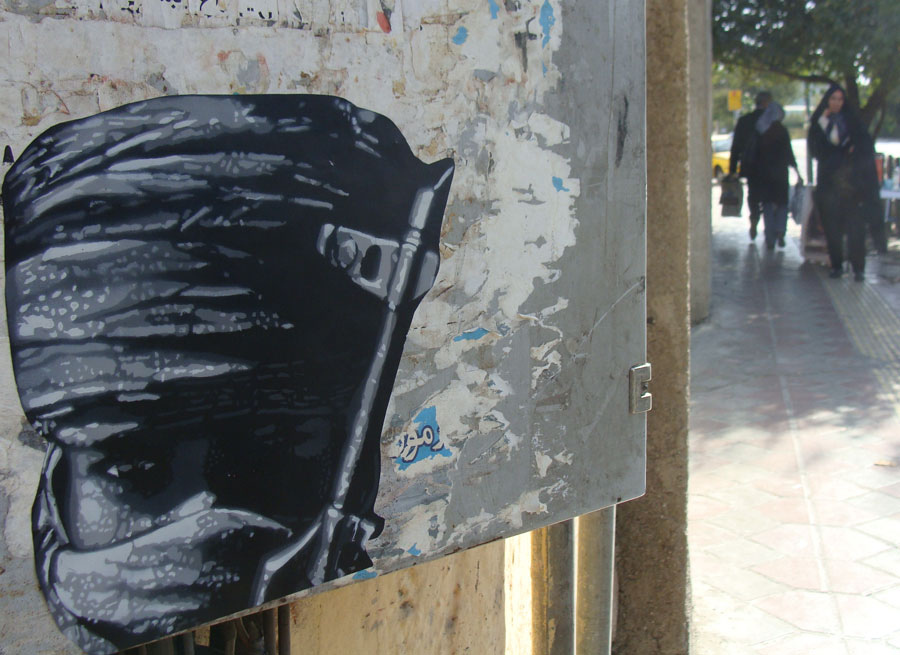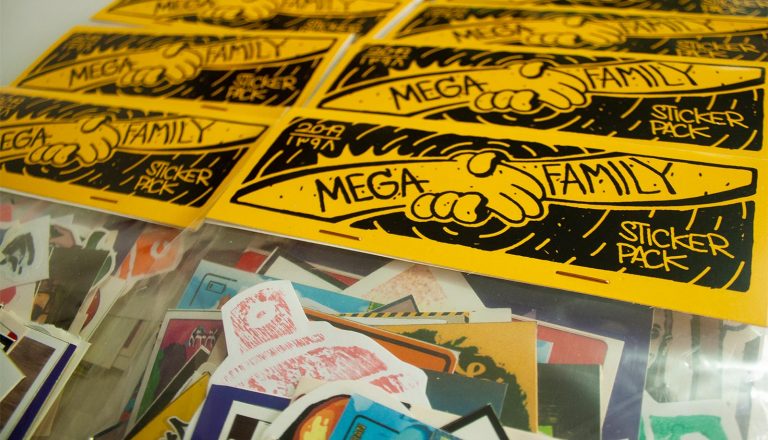
LSD Magazine Interview with Icy and Sot
if you peer past the stereotypes, endless propaganda on both sides of the divide and the dark theocratic veil of Iran, it won’t be long before you touch both the not so silent underground and the extraordinarily nuanced pathos of Icy and Sot’s art. Infusing the international visual language of global street art with a deeply personal and targeted meaning, their spectacular range of work takes on the political, the individual and the universal as haunting flashes of innocence sweep through bold statements of identity, freedom and social justice. Whether it be superbly layered stencils rendering an almost photographic sense of fleeting memory, silent screams of humanity, intensely political canvases beckoning a new dawn of cultural freedom or quick cheeky pastes in Tehran’s streets, they have truly made the medium their own and made the stencil and the can sing their own biting refrain. They were open enough and brave enough to speak to LSD, although we did keep our direct political questions to a minimum. If its a tale of resistance and the triumph of the spirit you’re after – the art does all the talking you need
Tell us a little about Tabriz and the creative scene there
Its a city in the north-west of Iran, and kinda boring – there really isn’t much going on here to be honest. It does have really beautiful countryside and landscapes surrounding it, but all the creativity is mostly focused on the traditional art fields
How did you first develop an interest in art
It started with our career in skateboarding, especially Sot’s. We used to watch skate videos and play skate games all the time, and we saw graffiti and stencils on the walls which initially sparked our interest. We then started with small things like stickers and small amateur stencils, and we began spraying them and posting them up on our spots and gathering places.
How did being brothers and working together influence the development of your art
We were and are best friends, and when we started, there were very few people (most of whom were in our circle of friends) who knew what graffiti, stencil and the whole street culture was. Being brothers helped us a lot as we did everything together – drinking, hanging out, stenciling – everything and overall we just understood each other.
When did you first begin to cut stencils and how differently did you have to approach that from canvas pieces
A few years ago when we began thinking about our first exhibition and we started sophisticating our works around 2008.Is your art seen as a political statement in Iran Well it is, even our non-political works are considered offensive to the government and it’s also illegal like everywhere else except for the glaring fact that it’s much more dangerous for us here as the accusations potentially leveled at you go way beyond vandalism and criminal damage, so the risks are far greater

How do the public respond to your work and how does that differ with the reaction of the authorities
Graffiti and stencil has a long way to go before it becomes a part of our culture, and people realise what it really is. because of the lack of exposure here in this field, people aren’t familiar enough with these sorts of things., maybe if a pedestrian passes by a graffiti or stencil they might not know what it is or they might not have any interest in it, or maybe in some cases they might even wipe it off. For an example Icy once did a wheatpaste, went away for a few minutes just for it to dry off and when he came back a guy was tearing it off. But despite all of this it does now and again impact and influence some people on very rare occasions What does the imagery of childhood and children mean to you Innocence and the fact that they aren’t poisoned by the world around them. Child labour is still an issue all over the world.
Tell us about the Scream
Its a way of showing “Relief” and “Objection”
How important is the chador (veil) as a symbol
Its mostly a symbol of stereotype and old fashioned Iran, and mostly just to show that the characters that we use are Iranian – nothing important!

How important is location to the placement of your work – and does your choice of location vary with the piece of art
Our priority is mostly the safety of the area and the rate of spectators that pass by there, But other things such as texture and colour play a major part in the placement too. How do you create the haunting, fading sense of a lost memory in some of your black and white stencils By the facial reactions and the emotions.
Tell us a little about the wider Iranian street art scene
The street art scene in Iran is not much different to what’s going on in our own city, except in Tehran. It’s much more common there, and it has started to become a part of people’s lives. Therefore most of our street works are in Tehran. Yet it’s illegal and dangerous everywhere.We notice that some of your stencils are pasted internationally – do you travel much or do other artists paste up your stencils for you Our current state is all about that. We’ve got friends worldwide and they do it for us, but we would really like it if we could do it ourselves. Unfortunately, in Iran our travel options are severely limited, and before a man can exit the country he has to do a year and a half of military service so that he can get his passport. Because of that, we decided to drop school and pass this goddamn period of time.We have spent one year of that year and a half so far.
What possibilities does canvas open up beyond the scope of a stencil
We work on canvases for our exhibitions and to be able to sell our work.

How much has the internet revolutionised and internationalised your art
Everything from our photostreams to our Facebook page, without it we would never had this interview.How much is there an international language of street art and how easily do specific cultural issues of a certain country speak through that languageI really think street art could be a good way of connecting different cultures to each other, it could be a matter of problems going on in that country or just a regular street art performance. All the street artists around the world are very much alike, in their lifestyle or in the way they think and see things.
How did your recent exhibition on Tehran go
It was great. We had plenty of visitors and we got to know a lot of new people and artists and they got to know us as well . It was a huge success and we even had a few foreign visitors
How optimistic are you about the future of Iran
We hope someday there will be freedom of expression and democracy like other places in the world.
What is the dream for the two of you
To work and exhibit all over the globe, and show our artwork to the people of the world and to be influential
مصاحبه مجله ال اس دی با آیس و سوت
اگر نگاهی به افکار جاافتاده و تبلیغات بی پایانی که بر پرده ی تاریک حکومتی ایران وجود دارد بیندازید، زمان بسیار دوری نیست که از هنر نچندان خاموش زیرزمینی و فوق العاده تیزبینانه ی Icy & Sot تأثیر میگیرید. آثاری که زبان دیداریِ هنر خیابانی جهان را با یک مفهوم عمیق شخصی و هدف گیری شده القا میکنند. محدوده ی تماشایی کار آنها به تنهایی و بطور گسترده ای با سیاست مبارزه میکند. با اظهارات دلیرانه ی خود و با نشان دادن بی گناهی ها، هویت، آزادی و عدالت اجتماعی. چه این کارها استنسیل های چندلایه ای باشند که فریادهای خاموش انسانیت را تعبیر کنند، چه نقاشی های سیاسی ای که اشاره به یک آزادی جدید فرهنگی دارند، و چه کارهای چسبان گستاخانه و سریع در خیابان های تهران. به راستی که آنها رسانه را متعلق به خود کرده اند و سرود قوطی ها را کروس آواز خود کرده اند. آنها به قدر کافی آزاد و شجاع بودند که با LSD صحبت کنند، و ما نیز سوالات سیاسی خود را به حداقل رساندیم. اگر این حکایتی از ایستادگی و موفقیت است، هنر همه ی آنچه را که نیاز دارید به شما می گوید.
کمی راجع به تبریز و خلاقیت های آنجا بگویید؟
تبریز شهری در شمال غرب ایران است، کمی تا حدودی خسته کننده است، درواقع هیچ چیز خاصی ندارد. اطراف آن حومه و چشم اندازهای زیبایی وجود دارند اما همه ی خلاقیت های آنجا روی شاخه های هنر سنتی متمرکز شده اند.
اولین بار چطور علاقه تان به هنر را گسترش دادید؟
اول با کارمان در اسکیت برد شروع شد، مخصوصا Sot. ما عادت داشتیم تمام وقت اسکیت بازی کنیم و فیلم های اسکیت بردینگ نگاه کنیم، و آنجا گرافیتی و استنسیل ها را میدیدیم، که اولین جرقه ی علاقه مان بود. بعد با چیزهای کوچکی مثل استیکرها و استنسیل های آماتور شروع کردیم و آنها را روی دیوارهای جاهایی که وقت میگذراندیم یا دورهم جمع میشدیم زدیم.
برادر بودن چه تأثیری روی پیشرفت هنرتان داشت؟
ما بهترین دوستان هم بودیم و هستیم، و وقتی شروع کردیم افراد خیلی کمی بودند که بدانند گرافیتی، استنسیل یا درکل فرهنگ خیابانی یعنی چه، اکثرا فقط دوستان اطراف خودمان میدانستند. برادر بودن خیلی به ما کمک کرد، وقتی که همه ی کارهایمان را باهم انجام دادیم – خوردیم، چرخیدیم، استنسیل زدیم – همه چیز، و روی هم رفته همدیگر را شناختیم.
اولین بار چه زمانی شروع به بریدن استنسیل ها کردید و آن را روی پارچه ی نقاشی امتحان کردید؟
چند سال پیش وقتی که راجع به اولین نمایشگاهمان فکر کردیم، و شروع به رنگ و آب دادن به کارهایمان کردیم، حدود سال 2008.
آیا هنر شما در ایران سیاسی تلقی میشود؟
بله، حتی کارهای غیرسیاسی ما هم برای دولت زننده و اتهام آمیز دیده میشود و مثل هرجای دیگر غیرقانونی ست. اما حقیقت این است که اینجا برای ما خطرناک تر است، وقتی انگشت اتهاماتی که به سمت ماست فراتر از خرابکاری و آسیب های سیاسی میرود، ریسک ها برایمان بزرگتر هستند.

مردم چه واکنشی در برابر هنر شما نشان میدهند؟ و چه فرقی با واکنش افراد دولتی دارد؟
گرافیتی و استنسیل راه بسیار طولانی ای را طی کرده است تا اینکه بخشی از فرهنگ ما شود و مردم بفهمند که واقعا چیست. به دلیل کمبود ارائه یا در معرض گذاری، اینجا در این رشته، مردم بطور کافی بااین چیزها آشنا نیستند. اگر یک عابر از کنار یک گرافیتی یا استنسیل رد شود، ممکن است نفهمد که چیست، ممکن است علاقه ای به آن نداشته باشد، یا در برخی مواقع حتی ممکن است آن را پاک کند. برای مثال یک بار Icy یک کار چسبی زد و فقط چند دقیقه از آنجا رفت تا کار خشک شود، و وقتی برگشت شخصی داشت آن را میکند. اما برخلاف همه ی اینها، هنوز هم این کارها روی برخی از مردم جواب میدهند، آنها را تحت فشار قرار میدهند و تأثیر خود را میگذارند.
مجسم کردن دوران کودکی و کودکان چه معنایی برای شما دارد؟
بی گناهی، و این حقیقت که آنها توسط دنیای اطرافشان مسموم شده اند. کار کردن کودکان هنوز در همه جای دنیا یک معظل به شمار می رود.
کمی راجع به ‘ فریاد ‘ بگویید
راهی برای نشان دادن تسکین و مخالفت است.
چادر (حجاب) چقدر بعنوان یک سمبل مهم است؟
بیشتر سمبلی از ایران کلیشه و قدیمی است. برای نشان دادن این است که کاراکترهایی که استفاده میکنیم، ایرانی هستند. چیز مهمی نیست.

مکانی که قرار است کارتان زده شود چقدر مهم است؟ و آیا انتخاب مکان باتوجه به کار تغییر میکند؟
اولویت ما بیشتر امنیت مکان و میزان بیننده هایی هستند که از آنجا عبور میکنند، اما چیزهای دیگری مانند بافت و رنگ نیز نقش مهمی را در انتخاب مکان ایفا میکنند.
چگونه این محوشدگی های فراموش نشدنی را در بعضی از استنسیل های سیاه و سفیدتان خلق میکنید؟
با دقت در عکس العمل ها و احساسات مربوط به صورت و پیاده کردن آنها روی استنسیل.
راجع به صحنه ی هنر خیابانی در ایران کمی بیشتر برایمان بگویید.
صحنه ی هنر خیابانی در ایران با چیزی که در شهر ما درحال وقوع است تفاوت چندانی ندارد، جز در تهران. آنجا خیلی عادی تر است، و بخشی از زندگی مردم شده است. بخاطر همین اکثر کارهای ما در تهران است. اما هنوز همه جا خطرناک و غیرقانونی ست. ما متوجه شدیم که برخی از استنسیل هایمان در جاهای مختلف دنیا زده میشوند.
بیشتر خودتان سفر میکنید یا هنرمندان دیگر استنسیل هایتان را برایتان میزنند؟
موقعیت اخیر ما کاملا مربوط به همین است. ما دوستان زیادی در سراسر جهان پیدا کرده ایم و آنها برایمان این کار را انجام میدهند، اما واقعا دوست داشتیم خودمان انجامش دهیم. متأسفانه در ایران امکان سفر ما شدیدا محدود است، و قبل از اینکه مردی بتواند از کشور خارج شود باید یک سال و نیم سربازی بگذراند تا بتواند پاسپورتش را بگیرد. بخاطر همین، ما درس خواندن را رها کردیم تا این دوره ی لعنتی را بگذرانیم، تقریبا یک سال و نیم را گذرانده ایم.
بوم نقاشی چه امکاناتی را برای استنسیل هایتان فراهم می آورد؟
ما برای نمایشگاه هایمان و برای اینکه قادر باشیم کارهایمان را بفروشیم روی پارچه ها کار میکنیم.

اینترنت چقدر هنر شما را منقلب و جهانی کرده است؟
همه چیز را منقلب کرده است، از فوتو استریم ها گرفته تا صفحه ی فیس بوکمان، همه با اینترنت ایجاد شده اند. بدون اینترنت، ما هرگز این مصاحبه را نداشتیم.
چگونه یک زبان بین المللی از هنر خیابانی وجود دارد؟ و چگونه معظلات فرهنگی یک کشور خاص به سادگی بااین زبان صحبت میکند؟
به عقیده ی ما هنر خیابانی واقعا راه خوبی برای متصل کردن فرهنگ های مختلف به یکدیگر است، که این هنر میتواند نشان دادن یک مشکل موجود در آن کشور باشد و یا یک نمایش خیابانی عادی. همه ی هنرمندان خیابانی در دنیا شبیه هم هستند، چه از نظر سبک زندگی و چه از نظر دیدگاهشان.
نمایشگاه اخیرتان در تهران چطور بود؟
خیلی خوب بود، ما بازدید کننده های فراوانی داشتیم و با مردم و هنرمندان جدیدی آشنا شدیم، آنها هم با ما آشنا شدند. موفقیت بزرگی بود، ما تعدادی بازدید کننده ی خارجی نیز داشتیم.
چقدر راجع به آینده ی ایران خوش بین هستید؟
ما امیدواریم روزی برسد که مانند جاهای دیگر دنیا آزادی بیان و دموکراسی داشته باشیم.
رویای هردوی شما چیست؟
اینکه در سراسر جهان کار کنیم و نمایشگاه بگذاریم، و آثار هنری خود را به مردم دنیا نشان دهیم و مؤثر باشیم.





